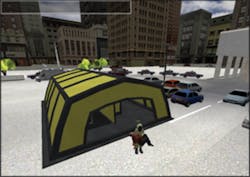Advanced computer simulation games help to transform healthcare and disaster preparedness.
Early one morning, a 911 caller reported an incident at a local shopping mall. The county HAZMAT team responded to what was discovered to be a chlorine gas attack on the mall. This first responder team managed to evacuate the mall and complete full decontamination of the site and people in just over 40 minutes. Unfortunately, there were eventually five fatalities resulting from the attack.
Advanced computer simulation games help to transform healthcare and disaster preparedness.
Early one morning, a 911 caller reported an incident at a local shopping mall. The county HAZMAT team responded to what was discovered to be a chlorine gas attack on the mall. This first responder team managed to evacuate the mall and complete full decontamination of the site and people in just over 40 minutes. Unfortunately, there were eventually five fatalities resulting from the attack.
Later that morning, a city fire department from the same region responded to an identical shopping mall incident. This first responder team managed to evacuate the mall and complete full decontamination of the site and people in 30 minutes. Fortunately, there were no fatalities.
Both of these first responder teams were using an interactive computer game called HotZone to execute and assess the effectiveness of alternative strategies for responding to the disaster, so no actual lives were lost. However, a great deal of practical experience was gained, and comparing the different results gave all parties clear guidance about what worked and what did not.
This is one example of the application of interactive computer games in the ever-expanding continuum of healthcare. Although healthcare delivery is often divided into organizational silos–ambulatory care, acute care hospitals, emergency rooms, critical care, post-acute care, public health services, etc.–the need to plan, train and prepare for new situations that require the coordinated interactions of many healthcare organizations grows every day. These needs are even greater when looking outside the modes of delivery to include other areas of the healthcare continuum such as prevention and disaster response.
From Simulation to Virtual Reality
Simulations and games are not new. Organizations have used these tools as a part of training and planning for decades. One only needs to think of the aviation industry and the military to find examples of the longstanding use of such technologies. It is the recent availability of computer simulations and games that are leading to a wave of innovative planning and training that is affecting all industries–particularly healthcare.
We have all seen, read about or participated in a fire drill or a hospital disaster simulation. They are a good way to validate plans and test preparations for an actual emergency. A great deal can be learned through executing such drills–even if they don’t fully accomplish their goal (e.g., evacuating the building, treating all the casualties within a certain time). They are also very expensive and time consuming to organize and to execute. Even with the most detailed planning, not every action of every participant will be recorded for later analysis. Restarting such simulations at an intermediate point in order to try an alternate action or plan is impossible.
Computer-aided simulations are an important supplement and extension to such manual simulations in several ways. First, they are much easier and less expensive to execute repeatedly to test different approaches and decisions. A well-constructed computer simulation will make it easy to analyze the end-states of different executions. Such computerized simulations can include very complex rules to govern the actions and reactions covered by the simulation. Still, computer-aided simulations are generally limited by the rules they contain and the fixed set of parameters included. The rules are programmed, the parameters values are specified, and the simulation is run. Direct participant experience is also limited.
Computer games are an extension of such simulations. They combine the best factors of both manual and computer-aided simulations while providing an interactive, graphics-based user interface. Computer games add the factor of real-time human interaction during the execution, and so combine the experience of a manual simulation with the complexity and ease of reproduction of the computer-aided simulation.
Multiplayer computer games also incorporate communication and cooperation to allow for more accurate reproduction of team settings. Game scoring, and the associated competition, is a natural motivator for repeated plays and improved results. Players will interact with the game environment and receive a virtual experience that would not be a part of a computer-aided simulation. Finally, games are fun, and they build upon the recreational experiences of many of the participants.
Examples of Innovation
The U.S. Army has six new Medical Simulation Training Centers (MSTCs) in operation today with 12 more scheduled to be operational before the end of 2007. The MSTC program will provide training for combat medics and create a standardized program of instruction in medical simulation. Eventually this training will be extended to teach combat-lifesaving techniques to all soldiers.
At Stanford University, the Medical Media and Instructional Technology group has recently used game technology to create a 3-D virtual emergency department. Actual residents and medical students, wearing head sets and standing at a computer keyboard, use menu buttons to control the actions of their on-screen avatars in a virtual environment ER and learn the best responses to a number of different trauma scenarios.
The Center for Advancement of Distance Education developed a computer-based video game simulation for training public health officials and emergency responders to coordinate a mass drug-dispensing center following an anthrax attack. Computer game technology has been applied to uses as diverse as pain management, diagnosing dyslexia by educators and parents, and creating greater disease awareness among physicians.
Noblis, a nonprofit science, technology and strategy organization that helps clients solve complex systems, process and infrastructure problems, has recently developed a multiplayer game called HotZone. It is used to train teams of first responders in dealing with a terrorist event. The game deals with a chlorine gas attack at a shopping mall that is further complicated by an explosion in the parking lot. The team must stop the source of chemical contamination and rescue victims while communicating with each other and an incident commander. This is an example of a team-with-a-mission training game where each player acts and sees the environment individually while communicating and working together.
In the multiplayer game, the team of first responders directed by an incident commander, must effectively and efficiently set up a security perimeter and a decontamination facility; find and shut down the chlorine source; triage the mall civilians and evacuate them from the mall; decontaminate the victims and, as needed, send them to a hospital. Finally, the first responders must remove their suits and be decontaminated. The basic success measures of HotZone are the conditions of the victims at the end (e.g., lives lost) and the time to complete the operation.
The Critical Innovation
This game-based training environment is designed to incorporate multiple variables such as numbers of participants and victims, skill level of first responders and relative effectiveness of the measures taken. These can be adjusted to reflect the actual situations anticipated, or to build “ideal” response scenarios. The key innovation underlying the simulation is a capability, called Game Analysis, which captures and analyzes all of the data generated during the play of a game.
Rather than only taking snapshots to be used as restart points, Game Analysis captures each player’s action and all communications during the game in a database. It then provides a suite of visual representations of the strategies used by the team and the associated results. For example, a Gantt chart is generated to show the sequence of tasks performed by the team and how long it took them to complete those tasks.
Additionally, the performance and style of play for each trainee is captured and can be related to their professional background, skills and training. The capture, display and analysis of gameplay data allows for better strategies to be developed. Different skills mixes, changes to the way players communicate between themselves and with their incident commander–all are factors that can have major impact on the outcome of the scenario.
Game Analysis has been designed to serve as a framework for other individual or multiplayer training games via the use of an XML standard format to collect game data. Each tailoring of Game Analysis to a new game requires the construction of a unique game-specific grammar (reflecting the range of actions allowable in that particular game). This grammar is used to parse the individual gameplay data into meaningful units for automatic strategy analysis.
The Future of Gaming in Healthcare
Games are becoming serious business. Multiplayer, interactive games are increasingly being used to train individuals and teams in diverse industries. Games are particularly appropriate for training people to function better in complex settings and as members of a team with a mission. Multi-player games are excellent vehicles for helping to train teams, even using equipment that has not yet been fielded in the “real world.” In such games, coordination and cooperation between the team members are required for success.
For more information on
Noblis
This serious gaming phenomenon is occurring within healthcare as well. Efforts have begun to organize and share information between groups exploring the field. The Serious Games Initiative, a group founded at the Woodrow Wilson Center for International Scholars, in Washington, has been hosting annual conferences since 2004. These conferences focus on how games and game technology can address healthcare concerns and bring together medical professionals and game developers to share information and experiences.
The use of multiplayer games for training is destined to grow. In the future we can expect some actual repeatable human processes such as certain ER procedures to be viewed as multiplayer games. In this scenario, the “players” are outfitted with RFID tags and their individual actions are captured and subsequently analyzed in order to improve their strategies using a capability such as Game Analysis. Areas where gaming technology can be applied truly know no limits.
Today, healthcare games are focused on activities that are costly and expensive to reproduce and where the stakes are extremely high, such as trauma care and mass casualty events. Eventually gaming can be expanded to include other types of events, such as the failures of key computer systems or other infrastructure components. The capabilities of game and simulation tools can only expand and grow more standardized with advanced rules-based logic, animation, data capture and analytics, multi-party play and virtual reality. At some point, even routine events such as patient flow and infection control will be gamed, with results leading to cost reductions as well as improved outcomes.
Paul Breslin, Clem McGowan, Ph.D, and Richard Sudol are senior researchers and Benjamin Pecheux is lead system analyst and researcher at the Center for Health Innovation, Healthcare Division, Noblis Inc.







